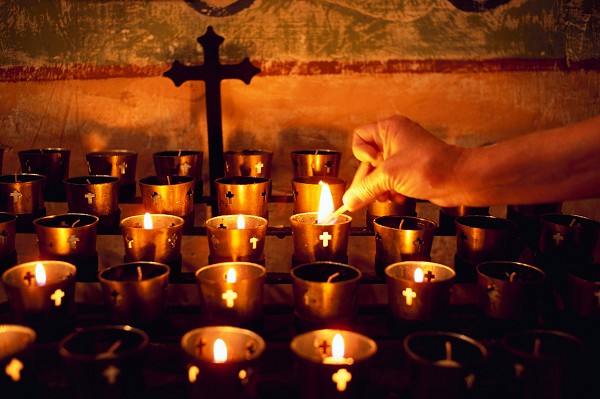An inspiring two days we’ve had: the canonization of Blessed Teresa of Calcutta followed by her first feast day as “Saint Teresa of Calcutta”–wow!
Here below is the full text of the Pope’s homily for her, as well as some other text from the Holy Mass on Sep 4, 2016.
“Who can learn the counsel of God?” (Wis 9:13). This question from the Book of Wisdom that we have just heard in the first reading suggests that our life is a mystery and that we do not possess the key to understanding it. There are always two protagonists in history: God and man. Our task is to perceive the call of God and then to do his will. But in order to do his will, we must ask ourselves, “What is God’s will in my life?”
We find the answer in the same passage of the Book of Wisdom: “People were taught what pleases you” (Wis 9:18). In order to ascertain the call of God, we must ask ourselves and understand what pleases God. On many occasions the prophets proclaimed what was pleasing to God. Their message found a wonderful synthesis in the words “I want mercy, not sacrifice” (Hos 6:6; Mt 9:13). God is pleased by every act of mercy, because in the brother or sister that we assist, we recognize the face of God which no one can see (cf. Jn 1:18). Each time we bend down to the needs of our brothers and sisters, we give Jesus something to eat and drink; we clothe, we help, and we visit the Son of God (cf. Mt 25:40). In a word, we touch the flesh of Christ.
We are thus called to translate into concrete acts that which we invoke in prayer and profess in faith. There is no alternative to charity: those who put themselves at the service of others, even when they don’t know it, are those who love God (cf. 1 Jn 3:16-18; Jas 2:14-18). The Christian life, however, is not merely extending a hand in times of need. If it is just this, it can be, certainly, a lovely expression of human solidarity which offers immediate benefits, but it is sterile because it lacks roots. The task which the Lord gives us, on the contrary, is the vocation to charity in which each of Christ’s disciples puts his or her entire life at his service, so to grow each day in love.
We heard in the Gospel, “Large crowds were travelling with Jesus” (Lk 14:25). Today, this “large crowd” is seen in the great number of volunteers who have come together for the Jubilee of Mercy. You are that crowd who follows the Master and who makes visible his concrete love for each person. I repeat to you the words of the Apostle Paul: “I have indeed received much joy and comfort from your love, because the hearts of the saints have been refreshed through you” (Philem 1:7). How many hearts have been comforted by volunteers! How many hands they have held; how many tears they have wiped away; how much love has been poured out in hidden, humble and selfless service! This praiseworthy service gives voice to the faith – it gives voice to the faith! – and expresses the mercy of the Father, who draws near to those in need.
Following Jesus is a serious task, and, at the same time, one filled with joy; it takes a certain daring and courage to recognize the divine Master in the poorest of the poor and those who are cast aside, and to give oneself in their service. In order to do so, volunteers, who out of love of Jesus serve the poor and the needy, do not expect any thanks or recompense; rather they renounce all this because they have discovered true love. And each one of us can say: “Just as the Lord has come to meet me and has stooped down to my level in my hour of need, so too do I go to meet him, bending low before those who have lost faith or who live as though God did not exist, before young people without values or ideals, before families in crisis, before the ill and the imprisoned, before refugees and immigrants, before the weak and defenceless in body and spirit, before abandoned children, before the elderly who are on their own. Wherever someone is reaching out, asking for a helping hand in order to get up, this is where our presence – and the presence of the Church which sustains and offers hope – must be”. And I do this, keeping alive the memory of those times when the Lord’s hand reached out to me when I was in need.
Mother Teresa, in all aspects of her life, was a generous dispenser of divine mercy, making herself available for everyone through her welcome and defence of human life, those unborn and those abandoned and discarded. She was committed to defending life, ceaselessly proclaiming that “the unborn are the weakest, the smallest, the most vulnerable”. She bowed down before those who were spent, left to die on the side of the road, seeing in them their God-given dignity; she made her voice heard before the powers of this world, so that they might recognize their guilt for the crime – the crimes! – of poverty they created. For Mother Teresa, mercy was the “salt” which gave flavour to her work, it was the “light” which shone in the darkness of the many who no longer had tears to shed for their poverty and suffering.
Her mission to the urban and existential peripheries remains for us today an eloquent witness to God’s closeness to the poorest of the poor. Today, I pass on this emblematic figure of womanhood and of consecrated life to the whole world of volunteers: may she be your model of holiness! I think, perhaps, we may have some difficult in calling her “Saint Teresa”: her holiness is so near to us, so tender and so fruitful that we continual to spontaneously call her “Mother Teresa”. May this tireless worker of mercy help us increasingly to understand that our only criterion for action is gratuitous love, free from every ideology and all obligations, offered freely to everyone without distinction of language, culture, race or religion. Mother Teresa loved to say, “Perhaps I don’t speak their language, but I can smile”. Let us carry her smile in our hearts and give it to those whom we meet along our journey, especially those who suffer. In this way, we will open up opportunities of joy and hope for our many brothers and sisters who are discouraged and who stand in need of understanding and tenderness.
Petition for Canonization of Mother Teresa of Calcutta
At the beginning of the liturgy, Cardinal Angelo Amato, SDB, Prefect of the Congregation for the Causes of Saints, accompanied by the Postulator, Fr. Brian Kolodiejchuk, MC, approached the Holy Father and asked him to procced with the Canonization of Blessed Teresa of Calcutta.
“Most Holy Father, Holy Mother Church beseeches Your Holiness to enroll Blessed Teresa of Calcutta among the Saints, that she may be invoked as such by all the Christian faithful.”
The Prefect of the Congregation of the Causes of Saints presents a brief biography of Blessed Teresa of Calcutta. Here is the biography presented in the prayer book for today’s ceremony:
Teresa of Calcutta (Gonxha Agnes Bojaxhiu) was born in Skopje, on 26 August 1910, the fifth and last child of Nikola and Drane Bojaxhiu. She was baptized the following day and received her First Communion at the age of 5½. From that time forward, she was filled with love for souls. In 1928, desirous of serving as a missionary, she entered the Congregation of the Sisters of Loreto in Ireland. She went to India in 1929, professed first vows in May 1931 and perpetual vows in May 1937. During the twenty years she spent teaching in India, she became known for her charity, zeal, devotion and joy.
On 10 September 1946, she received from Jesus the call “to leave everything behind and serve him in the poorest of poor.” In 1948, she obtained ecclesiastical permission to begin her apostolate in the slums of Calcutta. The Missionaries of Charity became a Religious Congregation of diocesan right on 7 October 1950, and were raised to a Congregation of pontifical right on 1 February 1965. The specific charism of the Congregation is to satisfy the infinite thirst of Jesus for love and for souls by working for the salvation and the sanctification of the poorest of the poor.
To extend her mission of love, Mother Teresa started the branch of the Missionaries of Charity Brothers (1963), the Contemplative Sisters (1976), the Contemplative Brothers (1979) and the Missionaries of Charity Fathers (1984), as well as the Association of cooperators, suffering cooperators, and the Corpus Christi movement for priests. At her death, on 5 September 1997, the Congregation numbered 3,842 Sisters, working in 594 houses in 120 nations.
Despite a painful experience of inner darkness, Mother Teresa travelled everywhere, concerned, like Mary in the account of the Visitation, to spread the love of Jesus throughout the world. She thus became an icon of God’s tender and merciful love for all, especially for those who are unloved, unwanted and uncared for. From heaven she continues to “kindle a light for those living in darkness here on earth.”
Formula of Canonization – Pope Francis
For the honour of the Blessed Trinity, the exaltation of the Catholic faith and the increase of the Christian life, by the authority of our Lord Jesus Christ, and of the Holy Apostles Peter and Paul, and our own, after due deliberation and frequent prayer for divine assistance, and having sought the counsel of many of our brother Bishops, we declare and define Blessed Teresa of Calcutta to be a Saint and we enroll her among the Saints, decreeing that she is to be venerated as such by the whole Church. In the name of the Father, and of the Son, and of the Holy Spirit.
Want to share her story with your children–so they can listen over and over (in the car, as a bedtime story, during quiet time or rainy days)? Then get our updated Glory Stories volume 4 CD “The Gospel on Five Fingers” with the all-new the bonus track, “What’s a Saint?” which explains the canonization process from start to finish (including the story of the miracle which cleared the way for Mother Teresa’s canonization)! Just click here now.
Ken Davison created Glory Stories, which became a weekly radio series heard globally on the Ave Maria Satellite Radio Network and EWTN’s radio network, WEWN. In 2007, he and his wife, Kerri, founded Holy Heroes–and their children stepped in to help shortly thereafter to create the online “Adventures” for Advent, Lent, Spiritual Adoption, and Marian Consecration.



![Official Blessing of the Christmas Tree [download]](https://blog.holyheroes.com/wp-content/uploads/2022/12/Blog-Header-2024-11-19T185735.318.jpg)
